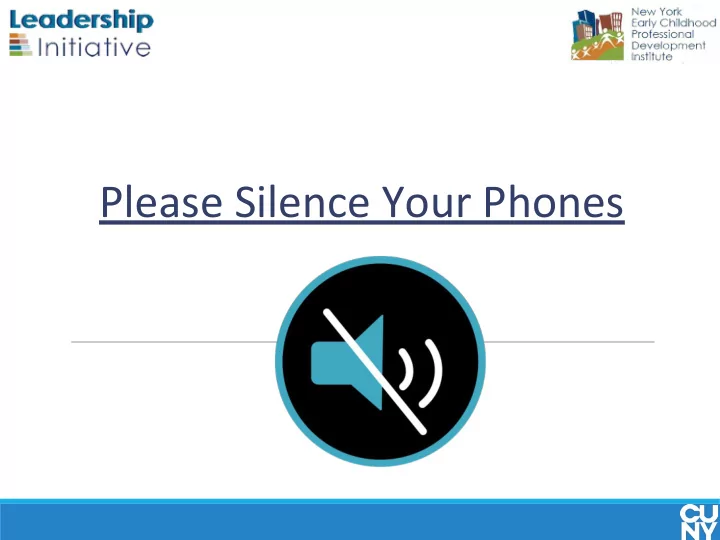

Please Silence Your Phones
From Survive to Thrive (STT): A Director’s Guide for Leading an Early Childhood Program
Facilitators Laura Ensler Claudine Campanelli President, Laura Ensler Consulting LLC Director of Career Development and Higher Education NY Early Childhood Professional Project Manager, CUNY PDI Leadership Initiative Development Institute
Chapter 1: What Does It Chapter 5: Program Mean to Be a Director? Curriculum Chapter 2: Program Chapter 6: Observation, Context and Culture Assessment and Documentation Chapter 3: Achieving and Chapter 7: Staffing Maintaining Program Quality Chapter 8: Working With Chapter 4: Budget and Families Finance Chapter 9: Center Enrollment
The Institute at CUNY Leadership Initiative
Chapter 2 Program Context and Culture History Program Culture Demographics Philosophy Resources Stakeholders
“In diversity there is beauty and there is strength. We all should know that diversity makes for a rich tapestry, and we must understand that all the thread of the tapestry are equal in value no matter their color.” -Maya Angelou, Rainbow in the Cloud: The Wisdom and Spirit of Maya Angelou
Poll Question On a scale of 1-5, how well do you understand the history of your program? A. 1 B. 2 C. 3 D. 4 E. 5
Information About Your P Analyzing Information About Your Program Gatekeepers Strengths/Needs Allies •• High Family •• Community •• Sponsoring Engagement Members Organization •• Need Consistency •• Business Owners in Staff Opportunities Obstacles •• Training for New •• Lack of Funding/ Hires to Clarify Budget Cuts Questions
Improvement Plan Identify the problem • Identify Problem • Develop a goal Engage • Set a realistic timeline Assess stakeholders • Continue to evaluate the program • Limit long term goals to 2-3 Create a Develop goals time-line for and action implementation steps
Creating and Cultivating Culture Meaningful and Risk Taking, Strong Welcoming Effective Reflection, and Relationships Environment Communication Growth
Strong Relationships
Meaningful and Effective Communication What Information is Best Timely Communication & Discussed Whole Group / Intentional Use of Time at a Staff Meeting? How Can You Ensure What Information is Best Multiple Perspectives are Conveyed Verbally? Being Heard? What Information is Best How Can You Identify and Conveyed via Written Problem Solve around Correspondence? Communication Barriers?
Welcoming Environment CLIMATE The ‘feel’ of the program or it’s CULTURE atmosphere. Reflects the expectations of the program made visible Reflects the collective attitude of staff in the practices that towards the program’s beliefs, values, and arise out of the norms. program’s beliefs, values, and norms. If the organizational climate is adjusted slowly over time, culture can change too.
Risk Taking, Reflection, and Growth Trying New Ideas Taking Carefully Considered Risks Using Mistakes to Learn, Reflect, & Grow
Poll Question Our Program is actively engaged in an anti-bias staff development and early childhood curriculum? Yes A. No B.
Core Body of Knowledge (CBK) https://www.earlychildhood.org/pdfs/CoreBody.pdf
Chapter 2: CBK Competency Area Professionalism and Leadership Area Core Competency Behaviors and Skills 6.1 Uses and follows all relevant ethical standards and a-j (pp. 73) professional guidelines 6.2 Develops the dispositions necessary to effectively support a-l (pp. 74) young children and their families 6.3 Displays professionalism in practice a-h (pp.75) 6.4 Exhibits commitment to ongoing growth and learning a-j (pp.76) 6.5 Exhibits classroom and program leadership skills a-j (pp.77) 6.6 Advocates for appropriate practices within early childhood a-e (pp.78 field
Chapter 2: CBK Competency Area Professionalism and Leadership Area Core Competency Behaviors and Skills 6.1 Uses and follows all relevant ethical standards and a-j (pp. 73) professional guidelines 6.2 Develops the dispositions necessary to effectively support a-l (pp. 74) young children and their families 6.3 Displays professionalism in practice a-h (pp.75) 6.4 Exhibits commitment to ongoing growth and learning a-j (pp.76) 6.5 Exhibits classroom and program leadership skills a-j (pp.77) 6.6 Advocates for appropriate practices within early childhood a-e (pp.78 field
NYS Children’s Program Administrator Credential (CPAC) The CPAC • 1. Administering Children’s Programs Competencies • 2. Financial Planning and Management of Children’s Programs outline topic • 3. Operations Management in Children’s Programs areas that reflect • 4. External Environment and Children’s Programs the competencies • 5. Designing Programs That Are Good For Children And Families New York State • 6. Seminar in Children’s Program Administration requires to meet Within each topic area are competency areas. the criteria of the CPAC Credential.
CPAC Competencies Topic Competency Competency area 3 A Management Systems • Use management systems in order to implement quality programs • Compare national models of program accreditation to assess the most appropriate model to pursue accreditation • Incorporate quality criteria into all aspects of program management 3 B Technology and • Identify effective software programs for operations management, including Communication computerized recordkeeping systems • Implement ways in which technology can facilitate communication • Maintain confidentiality when using technology • Use technology applications in curriculum 4 C Ethical and Professional • Govern ourselves and those at the facility with those ethical standards Standards • Model ethical conduct governing the child care and education field to all center personnel, including volunteers • Maintain confidentiality • Identify and collaborate with community family support systems and professional resources • Advocate on behalf of children, families, and programs by building relationships and communicating with elected officials
Professional Affiliations & Organizations • Leadership Initiative • NAEYC • NYAEYC • National Head Start Association • Leadership Orgs: • SHRM (Society for Human Resource Management) • Leading for Children
Resources Going forward, what more do you want to know more about? • Children’s Administrators Program Credential • Quality Stars • Core Body of Knowledge: Administration and Management • A relevant Book List • NAEYC Accreditation
Join us for a conversation at: We invite you to be a part of the Survive to Thrive continuing conversation. Join us on the Forum … . https://discussion.earlychildhoodny.org /c/leadership-initiative
Thank You for Joining Us Thank you Debbie LeeKeenan and Iris Chin Ponte, authors of From Survive to Thrive, and the NYC Department of Education for supporting the work of the Leadership Initiative! Contact the Leadership Initiative: leadershipinitiative@earlychildhoodny.org
Recommend
More recommend